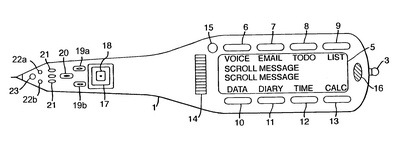The US Patent & Trademark Office has granted Apple a patent (RE42738) for a smart pen in regards to portable computers (think iOS devices and Mac laptops).
Per the patent, a portable computer arranged to rest comfortably in the hand has a small display screen. Accelerometers capable of detecting movement of the pen with respect to gravity provide input to a microcontroller which selects a response from a number of viewing modes. The pen may be held in either hand and the output message to the screen will be oriented according to the location of the pen. Full personal digital assistance functionality may be incorporated in a relatively small plastics casing and functions, such as calendar, contracts the like may be incorporated. Hillary L. Williams is the inventor.
Here’s Apple’s background and summary of the invention: “According to the present invention there is provided a portable computer including movement detection means responsive to movement of the computer to produce an electrical output signal representative of such movement, processing means responsive to the output of said position detection means to determine detected movement data defining a user’s intention, the processing means using said data to provide a mode response selected from a multiplicity of stored possible modes.
“Preferably the movement detection means includes at least one acceleration or tilt detection means responsive to movement of the computer to produce the output electrical signal. There may be a plurality of acceleration detection means each producing a respective electrical output signal representative of movement components in respective directions, the detectors generally being mounted to detect X and Y movement components at a ninety degree angle.
“The processing means may include a data input mode in which detected movement data is used to generate alphanumeric or graphical data. The alphanumeric or graphical data may be stored in data storage of the portable computer or may be output by transmitting means to receiving means connected to another processing device.
“The processing means may include a screen output mode in which detected movement data is used to modify output to display means of the computer whereby scrolling of displayed information is effected. In the screen output mode the processing means may be responsive to relative lateral tilting movement to cause the display of information stored as to one or other side of currently displayed information. Relative rolling movement may cause the display of information stored as above or below the currently displayed information.
“In the screen output mode the processing means may be responsive to detected movement data to determine a most likely orientation of the computer display means with respect to a user’s eye line whereby the signals output to the display means may cause inversion of the displayed information such that the computer may be held and used in either hand.
“The computer may include proximity detection means arranged to provide signals indicative of the proximity of the display screen to a user’s view, the processing means being responsive to changes in the relative proximity to increase or decrease density of displayed information.
“In a further development, security data derived from movement of the computer defining an authorised user’s password is stored, the processing means being locked in a secure mode until detected movement data corresponding to the security data is received.
“The computer may include a sound input device, the processing means having a second data input mode in which alphanumeric data is derived from input speech signals. A sound output device may also be included to permit the output of speech derived from stored data. Alternatively the sound input and output devices may be combined with a radio transceiver whereby cellular or other radio telephony networks may be used.
“The computer may be housed in a casing shaped to facilitate a user holding the computer as if holding a writing stylus. The casing is preferably of substantially radiused triangular cross section along a substantial portion of its length and may include a flattened section incorporating a display screen. The casing may include angular shaping between a forward holding area and a rearward screen area the shaping being such as to provide a natural viewing angle of an incorporated display screen while the casing is held as a writing stylus. The shaping may also be such as to facilitate support of the rearward screen area by the dorsal aspect of a user’s hand between the root of the thumb and index finger and the wrist.”
— Dennis Sellers

